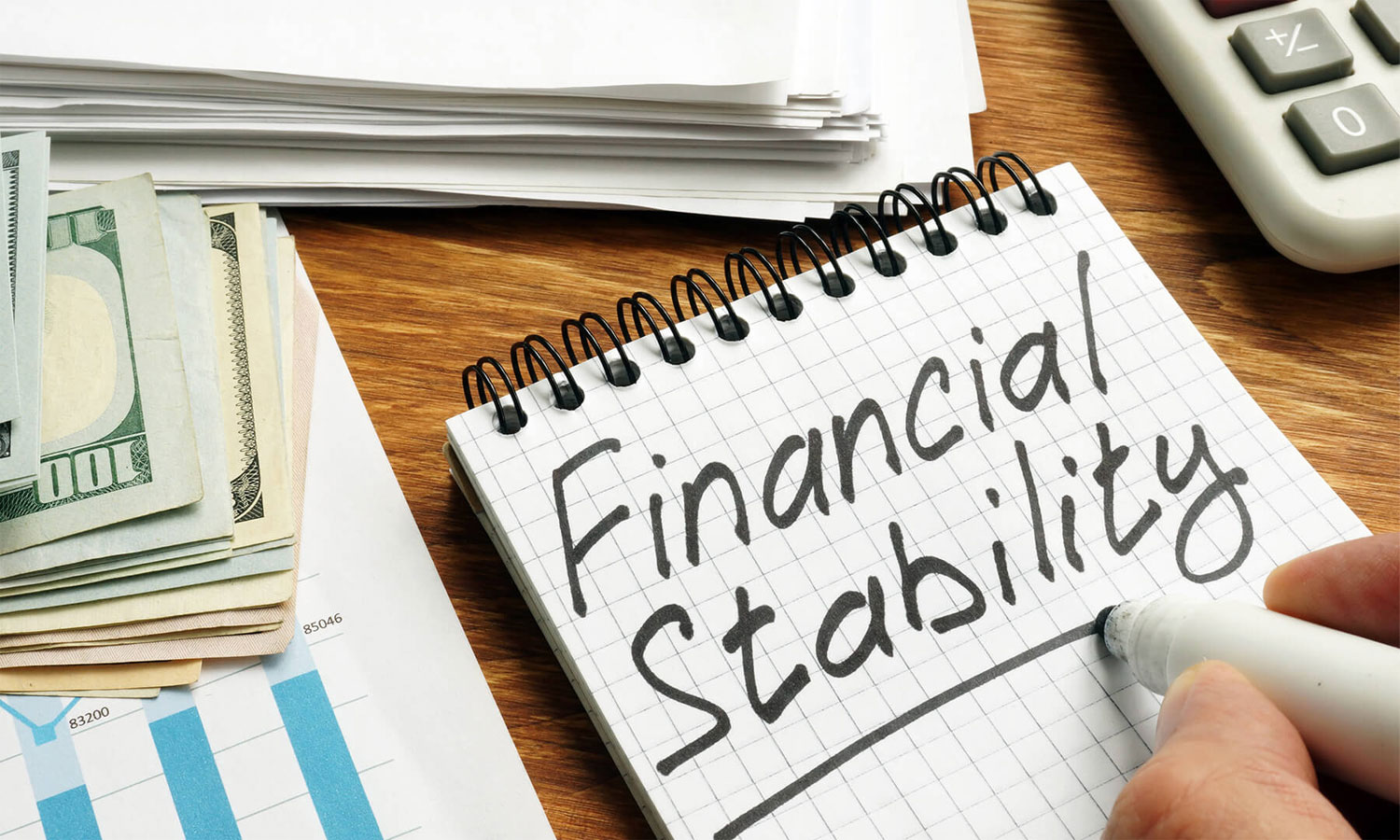10 Steps to Reach Financial Stability

Imagine a world where you don’t have to stress about money constantly. You have enough to cover your regular expenses, hobbies, and more. Plus, you want to control your finances, so you can afford the lifestyle you want to live. All this is possible when you achieve financial stability. To get there, you’ll want to follow a few important steps.
A financial advisor serving your area can help you set goals to achieve and maintain financial stability.
What does it mean to be financially stable?
When you are financially stable, you feel confident about your financial situation. You don’t have to worry about paying your expenses because you know you’ll have the funds. You are debt free, have money saved for your future goals, and have enough savings to cover emergencies.
Financial stability does not mean being rich. This is not a number at all. It’s more of a mindset. When you have financial stability, you don’t have to stress about money and can focus your energy on other parts of your life.
It may sound like a dream, but financial stability is something you can achieve. This will take some time and will need to be initialized. If you follow the ten steps below, you’ll be well on your way to achieving your financial dreams.
Step #1: Make your finances personal
Getting this straight off the bat is important: your finances are personal. It’s not personal because you can’t talk to anyone about your money. Personalizing your financial situation means focusing on your position and not worrying about someone else’s situation.
This is one of the most important things you can do to help you achieve financial stability. We live in a culture where we constantly compare ourselves to others. We are told to live a certain lifestyle because that is how successful people live.
Block out all that noise! Forget about keeping up with the Joneses. It doesn’t matter if your friends make more money than you. All that matters is how you can use what you have and what you can to achieve your goals.
Another important part of this rule is to forget the “right way” to do things. Yes, some financial decisions are usually better than others. But in terms of personal finance, a lot depends on the person himself. There is no one specific method or schedule that is best for everyone.
If you create a savings goal and miss it, don’t beat yourself up for doing it wrong. Just look at what happened. What went well and what didn’t? Use this information to improve next time.
Step #2: Your most important investment is yourself
Before ever considering investing in the stock market, you should try investing yourself. Invest the time, energy, and money to teach yourself the necessary skills. This includes college degrees. It also contains other knowledge and skills.
Learning things not directly related to your job can sometimes help you as much as job-related skills. Usually, bosses want good employees who can contribute to the company in several ways. They also want the person who drives and shows ambition to behave well.
Are your interview skills holding you back from landing that dream job? You can use classes, books, and online resources to improve next time. Improving your skills is always a good investment. This opens up more opportunities for you and increases your career earning potential.
Along with this, your health is also essential to achieve success. One thing that drains a savings account very quickly is medical expenses. While you can’t prevent all diseases, a healthy diet with regular sleep and exercise can go a long way. It also means limiting stress. Find ways to relax and unwind.
Step #3: Earn an income doing something you love
The main way most people earn money is through work. So, if you’re thinking about financial stability, the best place to start is with a job that pays you a steady income. The best thing is to find a job that you like.
Doing what you enjoy will make your job easier. For some people, this means changing careers. This means switching companies because you don’t like your current company’s people or structure. Perhaps your main thing is to find a part-time job and start freelancing. It may not be customary, but your happiness (and sanity) is more important after the convention.
Step #4: Start and stick to a budget
That’s right, to the budget. You’ve probably heard this advice before. But the budgets are not so bad. A budget is just a tool to help you spend money on the things you want to spend money on.
First of all, why is a budget important? When you keep a budget, you can track where your money is going. It’s easy to spend more than you should if you don’t know how much you’re spending. So, more than anything else, a budget helps you track your money.
Once you know how you spend your money, you can make a plan. There are always things you need to spend money on. This includes rent or mortgage, utility costs, food, a car, or commuting to work. These essentials should account for about half of your expenses. (Experts generally recommend that your rent/mortgage be no more than 30% of your monthly expenses.)
Then it would be best if you tried to put 10%-20% of the remaining money towards your future. That means your retirement account, emergency fund, and other savings accounts. After doing all this, the remaining money can be lived off.
You may want to determine how much you should spend on common things like food or clothes each month so you don’t overspend. No matter how much money you spend, try to spend it purposefully. Focus your money on the things that are important to you. Then you shortened the rest.
Step #5: Live below your means
Like creating a budget, this is a tip that many people hear. The problem is that many of us struggle to follow it. As mentioned in the first step (Make Your Finances Personal), we live in a world where we constantly hear about things to buy. It is very easy to spend money on extra things that we don’t need.
However, it is important to live below financial hardship for your financial success. If you regularly spend all your money, i.e., more than you earn, you can’t expect any savings to grow.
Living below your means works in tandem with a budget. Your budget tells you how much you can spend each month. Then you can work with that number to ensure you’re not overspending.
Step #6: Create an emergency fund
Before you think too much about retirement or putting money into your debt, you should make an effort to build an emergency fund.
It is a tool to protect against the unexpected in the background of an emergency. Losing your job and going without a regular paycheck is always possible. Maybe you must do a major car repair or go on an unplanned trip. An emergency fund will cover some or all costs and help you through difficult times. An emergency fund will also ease your mind by giving you a background.
Sometimes people put aside an emergency fund to save for retirement. Then a big expense arises, and they take money from their retirement account to cover it. A quick withdrawal from your retirement account should always be a last resort.
This detracts from your retirement savings, and you will probably have to pay a pension. For example, if you withdraw early from a 10(k), you must pay a 401% penalty.
Step #7: Pay off your debts
Debt will always make achieving financial stability difficult. Consider how much you can comfortably spend (via a budget) and focus on getting out of debt once you have an emergency fund. Pay off your credit card debt and avoid future debt on your cards. Have student loans? Pay extra to get rid of them as soon as possible.
Just because you signed up for a 10, 20, or 30-year payment plan doesn’t mean you can’t pay off your loans sooner. Paying off your loans sooner will save you money in the long run because you’ll pay less in interest.
The only caveat here is the bail. If you have a mortgage, you have some time to pay it off. Prioritize all other debts before the mortgage. You must still make all your mortgage payments but put extra money towards your other debts first. After your other debt is paid off and you’ve saved for retirement (step eight), you can focus on paying off your mortgage quickly (if you want to).
Step #8: Save and invest for retirement
It’s hard to think about retirement when you’re young. Why save money for something that lasts for decades? Unfortunately, the average American has no retirement savings because of this thinking.
If you want to achieve financial stability, you need to plan for the days when you will not have a salary. This is especially true if you plan to retire. Want to travel after retirement? Want to volunteer or take some local classes? These are all great things, but you can’t do them for free.
Make your retirement a priority now. You will thank yourself in the future. Even if you don’t have much saved for retirement, start now. Thanks to the magic of compound interest, someone who starts early will earn more in the long run.
Start working as you think about saving for retirement. Many employers offer 401(k) or 403(b) plans. Take advantage of them, especially when they offer suitable jobs for employers. An employer match is when your employer will match some or all of the contributions you make to your company’s retirement plan. Not taking advantage of boss fit is like giving away free money.
If your employer doesn’t offer a retirement plan, you can open an individual retirement account (IRA).
Step #9: Focus on having some fun
It’s easy to forget about fun when focused on saving money or paying off debt. After all, entertainment usually costs money. But don’t be so focused on your money that you forget to live. Enjoying life will help keep you happy and healthy.
When you focus on how much you can afford each month, budget a certain amount just for fun. Maybe you can get a massage every few months or go to show business. Keep looking for cheap and free events too. Go on a hike or invite friends for a game night. Another great way to have fun is to celebrate your financial successes. Just pay off one of your credit cards? Try one of these five frugal ways to celebrate your debt successes.
Step #10: Stick to your long-term financial plan
In an ideal world, you would stay within your budget every month. Your car will never need repairs, and you will never lose your job. Unfortunately, we do not live in an ideal world. Unexpected things happen, and sometimes you spend more money than you expected. Try not to get discouraged when things don’t go as planned.
Even when things don’t go well, stick with it. Stick with it even if you fall for weeks, months, or years. Don’t worry about making everything perfect. Do your best and try to get a little better every day.
If you’re having trouble sticking to a plan for your finances, a financial advisor can help.
Conclusion
Financial stability is the freedom to live on your terms without worrying about how you will pay your next bill. While this may seem like an unattainable dream for many people, it is within your reach. Follow the ten steps above, and you’ll be on your way to financial security.
Tips for achieving financial security
- Whether saving for retirement through a business plan or GO, a financial advisor can help you create a financial plan for your needs and goals. Finding an experienced financial advisor is not difficult. You can visit your consultant races at no cost to decide which is right for you. Start now if you’re ready to find an advisor who can help you reach your financial goals.
- An emergency fund will provide security when the unexpected happens. Where you keep your emergency fund is a personal decision. Some people keep an emergency fund in regular savings accounts. If you need a $10,000 emergency fund, you can ensure you have $000,000 in your savings account that you never touch. But there may be a desire to spend this money. In this case, you can create a separate savings account or open a money market account.












